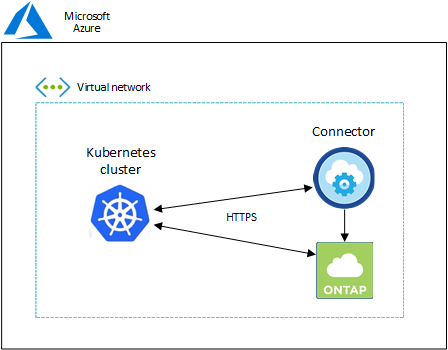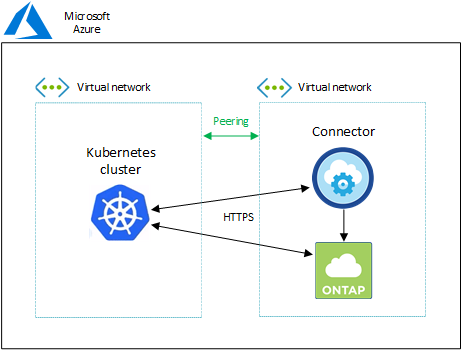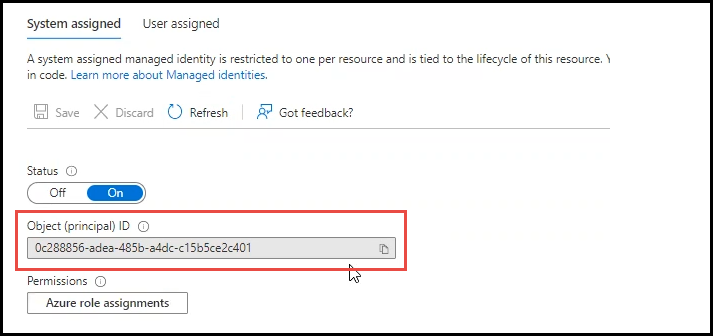Requirements for Kubernetes clusters in Azure
 Suggest changes
Suggest changes


You can add and manage managed Azure Kubernetes clusters (AKS) and self-managed Kubernetes clusters in Azure using BlueXP. Before you can add the clusters to BlueXP, ensure the following requirements are met.

|
This topic uses Kubernetes cluster where configuration is the same for AKS and self-managed Kubernetes clusters. The cluster type is specified where configuration differs. |
Requirements
- Astra Trident
-
One of the four most recent versions of Astra Trident is required. You can install or upgrade Astra Trident directly from BlueXP. You should review the prerequisites prior to installing Astra Trident.
- Cloud Volumes ONTAP
-
Cloud Volumes ONTAP must be set up as backend storage for the cluster. Go to the Astra Trident docs for configuration steps.
- BlueXP Connector
-
A Connector must be running in Azure with the required permissions. Learn more below.
- Network connectivity
-
Network connectivity is required between the Kubernetes cluster and the Connector and between the Kubernetes cluster and Cloud Volumes ONTAP. Learn more below.
- RBAC authorization
-
BlueXP supports RBAC-enabled clusters with and without Active Directory. The BlueXP Connector role must be authorized on each Azure cluster. Learn more below.
Prepare a Connector
A BlueXP Connector in Azure is required to discover and manage Kubernetes clusters. You'll need to create a new Connector or use an existing Connector that has the required permissions.
Create a new Connector
Follow the steps in one of the links below.
Add the required permissions to an existing Connector (to discover a managed AKS cluster)
If you want to discover a managed AKS cluster, you might need to modify the custom role for the Connector to provide the permissions.
-
Identify the role assigned to the Connector virtual machine:
-
In the Azure portal, open the Virtual machines service.
-
Select the Connector virtual machine.
-
Under Settings, select Identity.
-
Click Azure role assignments.
-
Make note of the custom role assigned to the Connector virtual machine.
-
-
Update the custom role:
-
In the Azure portal, open your Azure subscription.
-
Click Access control (IAM) > Roles.
-
Click the ellipsis (…) for the custom role and then click Edit.
-
Click JSON and add the following permissions:
"Microsoft.ContainerService/managedClusters/listClusterUserCredential/action" "Microsoft.ContainerService/managedClusters/read" -
Click Review + update and then click Update.
-
Review networking requirements
You need to provide network connectivity between the Kubernetes cluster and the Connector and between the Kubernetes cluster and the Cloud Volumes ONTAP system that provides backend storage to the cluster.
-
Each Kubernetes cluster must have an inbound connection from the Connector
-
The Connector must have an outbound connection to each Kubernetes cluster over port 443
The simplest way to provide this connectivity is to deploy the Connector and Cloud Volumes ONTAP in the same VNet as the Kubernetes cluster. Otherwise, you need to set up a peering connection between the different VNets.
Here's an example that shows each component in the same VNet.

And here's another example that shows a Kubernetes cluster running in a different VNet. In this example, peering provides a connection between the VNet for the Kubernetes cluster and the VNet for the Connector and Cloud Volumes ONTAP.

Set up RBAC authorization
RBAC validation occurs only on Kubernetes clusters with Active Directory (AD) enabled. Kubernetes clusters without AD will pass validation automatically.
You need authorize the Connector role on each Kubernetes cluster so the Connector can discover and manage a cluster.
- Backup and restore
-
Backup and restore requires only basic authorization.
- Add storage classes
-
Expanded authorization is required to add storage classes using BlueXP and monitor the cluster for changes to the backend.
- Install Astra trident
-
You need to provide full authorization for BlueXP to install Astra Trident.
When installing Astra Trident, BlueXP installs the Astra Trident backend and Kubernetes secret that contains the credentials Astra Trident needs to communicate with the storage cluster.
Your RBAC subjects: name: configuration varies slightly based on your Kubernetes cluster type.
-
If you are deploying a managed AKS cluster, you need the Object ID for the system-assigned managed identity for the Connector. This ID is available in Azure management portal.

-
If you are deploying a self-managed Kubernetes cluster, you need the username of any authorized user.
Create a cluster role and role binding.
-
You can customize authorization based on your requirements.
Backup/restoreAdd basic authorization to enable backup and restore for Kubernetes clusters.
Replace the
subjects: kind:variable with your username andsubjects: name:with either the Object ID for the system-assigned managed identity or username of any authorized user as described above.apiVersion: rbac.authorization.k8s.io/v1 kind: ClusterRole metadata: name: cloudmanager-access-clusterrole rules: - apiGroups: - '' resources: - namespaces verbs: - list - watch - apiGroups: - '' resources: - persistentvolumes verbs: - list - watch - apiGroups: - '' resources: - pods - pods/exec verbs: - get - list - watch - apiGroups: - '' resources: - persistentvolumeclaims verbs: - list - create - watch - apiGroups: - storage.k8s.io resources: - storageclasses verbs: - list - apiGroups: - trident.netapp.io resources: - tridentbackends verbs: - list - watch - apiGroups: - trident.netapp.io resources: - tridentorchestrators verbs: - get - watch --- apiVersion: rbac.authorization.k8s.io/v1 kind: ClusterRoleBinding metadata: name: k8s-access-binding subjects: - kind: User name: apiGroup: rbac.authorization.k8s.io roleRef: kind: ClusterRole name: cloudmanager-access-clusterrole apiGroup: rbac.authorization.k8s.ioStorage classesAdd expanded authorization to add storage classes using BlueXP.
Replace the
subjects: kind:variable with your username andsubjects: user:with either the Object ID for the system-assigned managed identity or username of any authorized user as described above.apiVersion: rbac.authorization.k8s.io/v1 kind: ClusterRole metadata: name: cloudmanager-access-clusterrole rules: - apiGroups: - '' resources: - secrets - namespaces - persistentvolumeclaims - persistentvolumes - pods - pods/exec verbs: - get - list - watch - create - delete - watch - apiGroups: - storage.k8s.io resources: - storageclasses verbs: - get - create - list - watch - delete - patch - apiGroups: - trident.netapp.io resources: - tridentbackends - tridentorchestrators - tridentbackendconfigs verbs: - get - list - watch - create - delete - watch --- apiVersion: rbac.authorization.k8s.io/v1 kind: ClusterRoleBinding metadata: name: k8s-access-binding subjects: - kind: User name: apiGroup: rbac.authorization.k8s.io roleRef: kind: ClusterRole name: cloudmanager-access-clusterrole apiGroup: rbac.authorization.k8s.ioTrident installationUse the command line to provide full authorization and enable BlueXP to install Astra Trident.
eksctl create iamidentitymapping --cluster < > --region < > --arn < > --group "system:masters" --username system:node:{{EC2PrivateDNSName}} -
Apply the configuration to a cluster.
kubectl apply -f <file-name>



 Get started
Get started